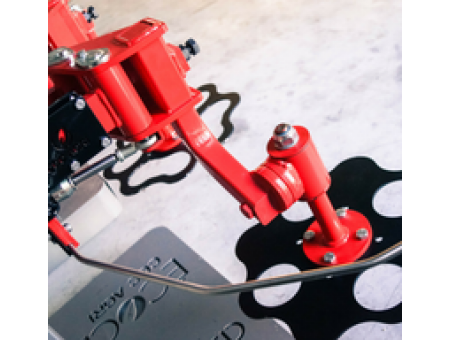In-row disc tool
In-row disc tools cut a strip of soil horizontally without moving soil, thus drying out the plants. The serrated or flat disc works at a slight forward angle and is available in a range of diameters.
The tool's retraction around the vines is ensured by a hydraulic system with a deformable parallelogram for precise pressure adjustment.
Key settings include the position of the tool, the safety margin determined by the sensor and the forward speed, optimised to avoid injury to the vines and ensure maximum efficiency.
The tool's retraction around the vines is ensured by a hydraulic system with a deformable parallelogram for precise pressure adjustment.
Key settings include the position of the tool, the safety margin determined by the sensor and the forward speed, optimised to avoid injury to the vines and ensure maximum efficiency.

Working objective
The working objective is similar to that of a tool with an in-row blade. This means cutting a strip of soil horizontally to a depth of a few centimetres, without moving the soil. This action causes the aerial part of the plant to dry out. This type of cultivation is known as flat cultivation, as opposed to ploughing, which modifies the relief of the soil.Components of in-row disc tools
Recently developed by CGC AGRI, the ECOCEP is an inter-row disc tool. Its simple, innovative design sets it apart from other inter-row tools on the market.The disc
Flat and crenellated, it works on a horizontal plant with a slight forward prickling (~4°). Different disc diameters are available.The erasing system
The tool is moved away from the foot by pressure and bypassing. It comprises a deformable parallelogram, a hydraulic accumulator and a single-acting cylinder. A control box adjusts the pressure in the tool's hydraulic circuit.Adjustment and use of in-row disc tools
Tool position
It must be centred in the row and the width of the tool must be correctly adjusted (taking into account the crossing of the tool) in order to avoid unworked areas and injury to the vines.The position of the feeler
This determines the safety margin between the tool blade and the vine stock. The greater the distance between the disc and the sensor, the greater the safety margin. In addition, the sensor should be as close to the ground as possible to determine the position of the vine as accurately as possible.Forward speed
This is fairly fast (up to 6 hm/h), but must not be too fast to allow the disc to return between the stumps.At CGC AGRI, the design of the ECOCEP simplifies settings. The tractor's hydraulics are only required to supply a certain pressure to the hydraulic circuit of the tool's clearing system. Once this stage has been completed, the tractor's hydraulics are no longer required. The shape of the disc and the deformable parallelogram ensure that the disc is eradicated by pressure and bypassing the stumps. The hydraulic unit determines the resistance to erosion (8 and 40 bars depending on soil type). A single-acting cylinder holds the tool in position under the row. When using the tool in plantations, it is preferable to add a feeler to trigger erosion facing the stumps.












